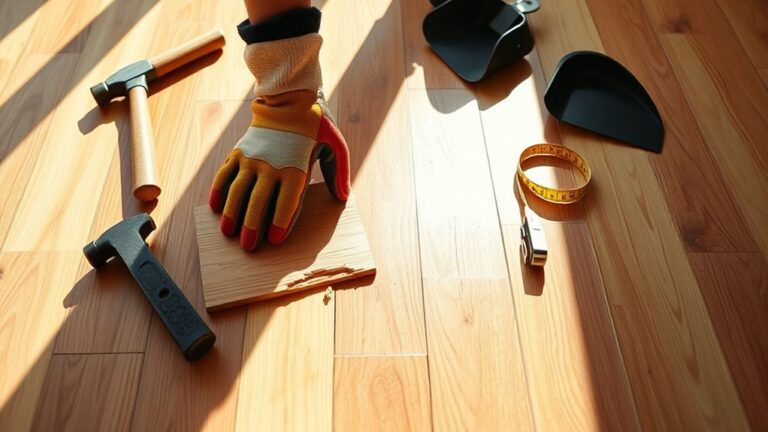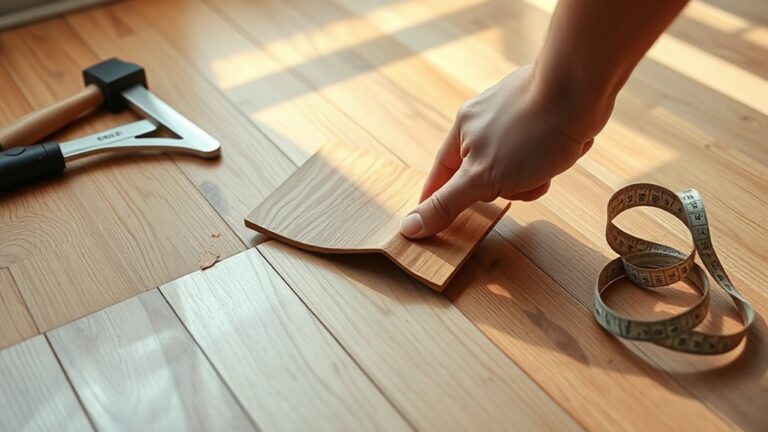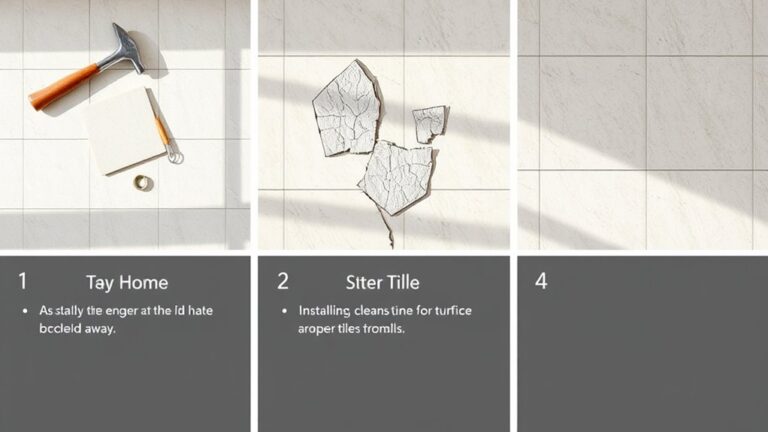When installing vinyl flooring in high-humidity rooms, you need to focus on moisture management and proper acclimation. Start by allowing your planks to acclimate for 2-3 days in the installation space to avoid gaps or warping. A moisture barrier is essential to protect against humidity from below. Choose manufacturer-recommended adhesives that can withstand high humidity and guarantee your subfloor is clean and level. Post-installation, maintain indoor humidity levels between 30% and 70% for peak performance. With the right preparation and care, your vinyl flooring can thrive beautifully in humid environments, assuring lasting functionality and style. There's more to discover!
Characteristics of Vinyl Flooring
When considering flooring options for high-humidity rooms, have you thought about the unique characteristics of vinyl flooring? Luxury vinyl flooring (LVP/LVT) is specifically designed to excel in environments like kitchens and bathrooms, thanks to its multiple layers, including a waterproof wear layer that effectively prevents moisture damage. This feature makes it an ideal choice for spaces prone to high humidity.
The durability of luxury vinyl flooring is another compelling attribute. Its thick, layered structure guarantees resistance to scratches, dents, and stains, allowing it to withstand the wear and tear of high-traffic areas. This means you won't have to compromise on style or performance, even in bustling environments.
Moreover, vinyl flooring incorporates microscopic air holes that enable it to adapt to temperature changes. This unique characteristic allows the flooring to expand with humidity and contract in cooler conditions, promoting dimensional stability. Such adaptability is essential in maintaining the integrity and appearance of your flooring over time.
Additionally, luxury vinyl flooring is available in a wide variety of styles, colors, and textures, mimicking natural materials like wood and stone while providing the moisture resistance you need. Importantly, its waterproof nature considerably reduces the risk of mold and mildew growth, contributing to a healthier indoor environment. With these characteristics, luxury vinyl flooring stands out as a practical and aesthetically pleasing option for any high-humidity room.
Importance of Acclimation
Acclimation is essential for luxury vinyl flooring, requiring a period of 2-3 days to adjust to the room's temperature and humidity. By placing the planks or tiles side-by-side, you guarantee a uniform adaptation, which minimizes the risk of expansion and contraction during and after installation. Neglecting this step can lead to dimensional instability, compromising both the appearance and functionality of your flooring.
Acclimation Duration Requirements
To guarantee ideal performance and longevity of your luxury vinyl flooring, it is important to allow it to acclimate for 2-3 days before installation. This acclimation period is essential as it enables the planks or tiles to adjust to the room's temperature and humidity levels, making sure they're ready for optimal performance.
During this time, you should place the vinyl pieces side-by-side on the floor. This setup makes sure of uniform exposure to the surrounding environment, allowing every plank to acclimate consistently. You can keep opened boxes of vinyl flooring in the installation area to facilitate this process, promoting compatibility with the room's climate.
Proper acclimation minimizes the risk of expansion or contraction post-installation, which is especially significant in high-humidity environments. If you skip this critical step, you might face issues like gaps or buckling in your flooring later on. Ultimately, failing to acclimate your flooring properly could compromise not only the installation but also the overall appearance and performance of your luxury vinyl flooring over time. So, take the time to let your flooring acclimate—it'll pay off in the long run.
Temperature Adjustment Benefits
Proper temperature adjustment during the acclimation period is essential for ensuring your luxury vinyl flooring performs at its best in high-humidity environments. By allowing your luxury vinyl planks to acclimate for 2-3 days, you minimize the risks of post-installation issues like expansion or contraction. This process involves placing the planks side-by-side in the installation area to properly adapt to the room's temperature and humidity.
A climate-controlled environment, ideally between 65°F and 80°F, is vital during acclimation. This helps prevent moisture-related issues, as luxury vinyl products expand with humidity, and proper adjustment reduces the chances of warping or gaps.
Here's a quick reference table to illustrate the benefits of acclimation:
| Acclimation Aspect | Recommended Action | Benefits |
|---|---|---|
| Duration | 2-3 Days | Allows proper adjustment |
| Environment Temp | 65°F – 80°F | best performance |
| Box Placement | Keep in installation area | Enhances temperature compatibility |
Proper Placement Techniques
When installing luxury vinyl flooring, understanding placement techniques is crucial, especially in high-humidity areas where fluctuations can lead to significant issues. Acclimation is a critical step that you shouldn't overlook. Ideally, you should allow the vinyl plank flooring to acclimate for 2-3 days before installation. This period enables the planks or tiles to adjust to the room's temperature and humidity levels, preventing potential warping or buckling down the line.
During this acclimation period, place the vinyl planks or tiles side-by-side on the floor. This arrangement guarantees even temperature distribution, allowing all pieces to adapt uniformly. It's also advisable to keep opened boxes in the installation area to facilitate this process without compromising the flooring's integrity.
To achieve peak performance, maintain the room's temperature between 65°F and 80°F during acclimation. This will help guarantee that your vinyl plank flooring performs well in the long term. By taking these acclimation steps seriously, you should be able to avoid common installation issues and enjoy your beautiful new flooring without worry.
Moisture Barrier Requirements
When installing vinyl flooring in high-humidity rooms, a moisture barrier is critical to prevent water damage and mold growth. You'll need to evaluate suitable underlayment options, especially if your subfloor has a history of moisture issues. Consulting with flooring experts can help you determine the best approach for your specific installation environment.
Importance of Moisture Barriers
Installing a moisture barrier is vital in high-humidity rooms to safeguard your vinyl flooring from potential damage. This protective layer acts as a shield against moisture sources below, preventing water damage and mold growth. When you're in humid environments, a moisture barrier helps maintain the integrity of your flooring by blocking moisture accumulation, which can lead to expansion, contraction, or warping.
Proper installation of a moisture barrier considerably reduces the risk of mold-related issues, ensuring longevity and durability in spaces like basements, bathrooms, or kitchens. It's essential to evaluate the effectiveness of your current vapor barriers and consider additional moisture management strategies. This could include sealing or improving ventilation to further shield your flooring.
When selecting a moisture barrier, consult flooring experts, as some luxury vinyl products may already include built-in barriers while others may need additional layers for ideal performance. By prioritizing a moisture barrier, you're taking an important step toward protecting your investment in vinyl flooring, especially in areas where humidity is a constant concern. Always remember, a well-installed moisture barrier is your best defense against the damaging effects of moisture.
Suitable Underlayment Options
Choosing the right underlayment is just as important as installing a moisture barrier, especially in high-humidity rooms. Using a moisture-resistant underlayment helps prevent mold and mildew growth by acting as a barrier against moisture from the subfloor. Here are some suitable underlayment options to take into account:
- Cork: Natural, moisture-resistant, and provides excellent sound absorption.
- Rubber: Durable and effective in resisting moisture, while also cushioning your flooring.
- Integrated Underlayment: Some luxury vinyl products come with this feature, simplifying installation.
When selecting your underlayment, verify it's compatible with the type of vinyl flooring you've chosen. This compatibility is vital for maintaining the overall integrity and performance of your installation. It's also wise to consult with flooring experts to understand the specific underlayment requirements based on the moisture levels in your space.
Selecting the Right Adhesives
Selecting the right adhesive is critical for guaranteeing the longevity and performance of vinyl flooring in high-humidity environments. In these settings, you need adhesives that are specifically recommended by the manufacturer for peak bond strength and durability. A popular choice is pressure-sensitive adhesives, like Parterre's Universal, which excel in humid climates. They can accommodate temperature fluctuations and maintain a strong bond, even under varying moisture conditions.
When choosing adhesives, focus on those that are water-resistant and capable of performing in relative humidity levels of up to 99%. This is imperative to prevent flooring failures due to moisture exposure, which can lead to costly repairs and replacements. It's important to evaluate environmental factors, such as the humidity and temperature of your installation space, as these elements greatly impact adhesive selection.
Consulting with Parterre representatives or flooring experts can provide valuable insights tailored to your specific installation conditions. They can help you navigate the options and find the best adhesive suited for your project. Remember, careful assessment of your environment is necessary to guarantee that the adhesive you choose can withstand the unique challenges posed by high humidity.
Installation Preparation Steps
Proper preparation is key to guaranteeing a successful vinyl flooring installation in high-humidity rooms. To start, you'll want to acclimate your luxury vinyl planks (LVP flooring) or tiles in the room for 2-3 days. This allows them to adjust to the temperature and humidity levels, minimizing issues later on.
Next, you should conduct porosity testing of the subfloor to determine the adhesive requirements. It's vital that the subfloor is clean, dry, and level before you proceed. Additionally, performing moisture vapor and pH testing on concrete substrates or radiant heated floors can help identify potential moisture issues that could affect your new flooring.
To further safeguard against humidity fluctuations, consider these essential steps:
- Use a moisture barrier or underlayment specifically designed for LVP flooring.
- Maintain a climate-controlled installation area with HVAC operational for at least 48 hours before installing to guarantee ideal conditions for the adhesive and flooring materials.
- Keep the area free from debris and dust to guarantee a smooth installation process.
Post-Installation Care Guidelines
After installing vinyl flooring, it's vital to follow specific care guidelines to guarantee its longevity and performance, especially in high-humidity environments. Start by maintaining the room temperature between 55°F and 100°F. This range promotes optimal performance and minimizes the risk of damage due to thermal expansion.
For the first 5-7 days post-installation, avoid machine scrubbing or stripping the flooring. The adhesive needs this time to cure fully, and any aggressive cleaning methods could compromise the bond and integrity of your flooring.
If you encounter spills or moisture exposure, address them promptly. Quickly cleaning up liquids prevents potential warping and staining, helping maintain the flooring's appearance over time.
To further protect your investment, consider utilizing UV-blocking window treatments. These can greatly reduce the risk of UV damage and thermal expansion, which is particularly important in high-humidity areas where fluctuations in temperature and moisture can occur.
Lastly, regularly monitor humidity levels in the room. Keeping humidity in check is vital as excessive moisture can lead to expansion and contraction of the vinyl. By staying vigilant about these post-installation care guidelines, you'll help preserve the functionality and aesthetic of your vinyl flooring for years to come. Remember, the right care not only enhances durability but also guarantees that your flooring continues to look great in your space.
Managing Humidity Levels
Managing humidity levels is essential for guaranteeing the longevity and performance of your vinyl flooring, particularly in high-humidity areas. You'll need to maintain relative humidity (RH) levels between 30% and 70% during installation to prevent any post-installation issues like expansion or contraction. In humid spaces, strong vapor pull from crawlspaces can lead to unwanted moisture, so implementing proper ventilation and moisture control is vital.
Here are some strategies to effectively manage humidity:
- Guarantee adequate ventilation: Use fans and vents in crawlspaces to minimize condensation and moisture buildup. This protects the integrity of your flooring.
- Regularly inspect vapor barriers: Check these barriers and underlayment to guarantee they're functioning correctly, preventing potential mold growth.
- Utilize humidistats: Automating ventilation systems based on humidity levels can provide a proactive solution to managing moisture in your home.
Cost-Effectiveness and Durability
Maintaining ideal humidity levels not only protects your vinyl flooring during installation but also enhances its cost-effectiveness and durability over time. Luxury vinyl flooring (LVF) is often a cost-effective choice compared to traditional options like hardwood or ceramic tile, especially in high-humidity rooms. Its multi-layered construction provides the resilience needed to withstand heavy foot traffic while resisting scratches, dents, and stains.
Here's a quick comparison of LVF versus traditional flooring options:
| Feature | Luxury Vinyl Flooring (LVF) | Traditional Flooring |
|---|---|---|
| Initial Cost | Lower | Higher |
| Maintenance Costs | Inexpensive | More Intensive |
| Lifespan | Long-lasting | Variable |
| Moisture Resistance | Excellent | Moderate to Poor |
| Repair Costs | Minimal | Often High |
Additionally, the inherent waterproof properties of LVF considerably reduce the risk of moisture-related damage, minimizing the need for costly repairs or replacements. As you invest in high-quality luxury vinyl products, you're likely to experience long-term savings due to lower maintenance costs and superior performance in challenging conditions. Regular cleaning is straightforward and won't break the bank, keeping your flooring looking great without extra hassle.
Design Options for High-Humidity Areas
When it comes to selecting design options for high-humidity areas, luxury vinyl flooring (LVF) stands out due to its adaptability and aesthetic appeal. You'll find that LVF is not only waterproof, preventing warping and moisture damage, but it also mimics natural materials like wood and stone. This means you can achieve the look you desire while guaranteeing durability.
Here are some design options to take into account:
- Natural Looks: Choose styles that resemble hardwood or stone, providing warmth and elegance in bathrooms or kitchens.
- Patterns and Textures: Explore various textures and patterns to add depth and character to your space, making it visually engaging.
- Color Variations: Opt for a color palette that complements your existing decor, allowing for personal expression while maintaining functionality.
Many luxury vinyl products come equipped with a built-in underlayment. This feature enhances comfort and sound insulation while serving as a moisture barrier, making them suitable for high-humidity rooms. The multi-layered construction guarantees that LVF maintains its appearance and functionality over time, even in moisture-prone areas.
Moreover, selecting options with scratch-resistant and durable top wear layers assures longevity and minimal maintenance. This is especially beneficial in high-traffic areas where spills and humidity are common. With these design options, you can confidently choose luxury vinyl flooring that meets your aesthetic and practical needs without sacrificing style.
Frequently Asked Questions
Does Humidity Affect Vinyl Flooring?
Yes, humidity does affect vinyl flooring. It can lead to expansion considerations, causing the planks to swell or contract in response to moisture changes. While vinyl is resistant to moisture, maintaining relative humidity levels between 30% and 70% is essential during installation. Acclimating the flooring for 2-3 days in the intended environment helps it adjust, minimizing the chances of post-installation issues and ensuring peak performance over time.
What Is the Best Flooring for High Humidity Areas?
When it comes to flooring in high humidity areas, think of a steadfast ship weathering a storm. Durable options like luxury vinyl flooring (LVP/LVT) are your best bet, designed to resist moisture and prevent warping. With a tough wear layer, these floors can handle spills and humidity with ease. Plus, many come with built-in moisture barriers, making installation simpler. For your space, these resilient choices provide the freedom from worries about damage or maintenance.
Can Moisture Get Under Vinyl Plank Flooring?
Yes, moisture can indeed get under vinyl plank flooring if proper precautions aren't taken. To prevent this, it's essential to use a moisture barrier effectively. This barrier helps to stop moisture from seeping up from the subfloor and causing issues like mold or mildew. Before you install, make sure to test your subfloor for moisture levels and consider using an underlayment for added protection. Regular inspections can help catch any potential moisture problems early.
What Should the Humidity Be for Flooring Installation?
You might think humidity isn't a big deal for flooring installation, but it really is. To guarantee optimal performance, you should maintain humidity levels between 30% and 70%. These Humidity Guidelines are essential as they prevent material expansion and contraction, leading to a stable installation. Before installing, acclimate your flooring materials for 2-3 days in the intended environment, and keep the area climate-controlled for at least 48 hours to achieve the right conditions.




